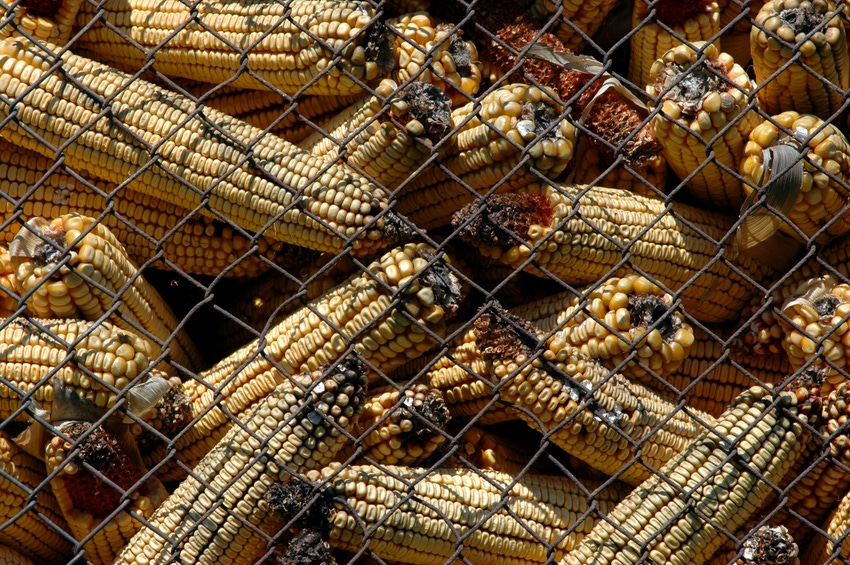Understand mycotoxin risks with corn, substitutes
One can never sample grains enough for mycotoxin presence, especially in years of high variability.
October 31, 2019

By KARI SADDORIS-CLEMONS*
*Dr. Kari Saddoris-Clemons is innovation lead-monogastrics at Cargill Animal Nutrition & Health.
This past planting season was challenging in many parts of the country. Abnormally wet weather patterns caused numerous delays, leaving some farmers unable to plant at all.
Under these circumstances, corn is expected to be in shorter supply this year, and many animal producers will need to look to alternative sources to feed their livestock.
Luckily, a variety of substitutes are available; however, each of these contain their own risks. Mycotoxins are a common topic during harvest, and while many associate them with corn, mycotoxins can be found in any plant-based feedstuff.
Projected corn risk
While it's too early to accurately determine the mycotoxin profile of this year's corn crop, aflatoxin is always a risk in corn raised in southern states due to the common experience of drought-like conditions and high humidity. Areas of wet, cool weather more common in the northern Corn Belt also can put corn at risk for both vomitoxin and zearalenone.
In the past month, dry conditions returned to previously wet regions of the southern and eastern Corn Belt. These conditions may heighten the risk for aflatoxin and fumonisin development.
Multiple stressors, such as very wet conditions, hail damage, insect damage and drought conditions, can lead to the presence of multiple mycotoxins. The expectation is that there may be a lot of regional variation in the mycotoxins present in this year's corn due to the extreme weather experienced in certain locations.
Different ingredients
Common corn substitutes that might see more use this year include wheat, wheat midds, bakery feed, pet food byproducts, cereal fines, barley, brewers grains and various corn-derived byproducts. As mentioned, all grains are at risk for the presence of mycotoxins, so monitoring mycotoxin levels will be critical this year.
The same precautions taken for corn must be taken with all grains, including regular, carefully managed sampling and analysis of alternative ingredients. While mycotoxin risks may be somewhat reduced in bakery feed, pet food byproduct and breakfast cereal fines, these alternatives are subject to extreme variability in nutrient content, so caution must be taken to diligently analyze the composition of each load, and diet formulations must be updated accordingly.
Also, it should be noted that plant byproducts, such as wheat midds, that could contain mycotoxins are sometimes blended into food industry or pet food byproducts to improve product flow and handling. These diluents can bring a mycotoxin risk to these otherwise lower-toxin-risk products.
What can be done?
In times of uncertainty: sample, sample, sample. One can never sample grains enough for the presence of mycotoxins, especially in years of high variability. Molds tend to grow in parts of fields or storage containers. Thus, grains can contain pockets of mycotoxins that can be missed if samples are not collected properly and frequently.
The U.S. Department of Agriculture has a great resource available to outline grain sampling procedures and best practices.
Additionally, knowing where feedstuffs are coming from allows you to benefit from survey information that may suggest geographic areas with higher mycotoxin risks.
Some quick rules of thumb include:
* Use the proper equipment. Grain at rest versus moving grain requires different sampling tools.
* Take the proper number and amount of samples. The general recommendation is 5-10 subsamples to represent the entire container of grain, and the larger the load, the greater number of samples you'll need to take.
* Properly pool, mix and subsample. All subsamples should be combined into a container and vigorously blended before sampling again to submit for analysis.
If samples are routinely or even occasionally coming back above threshold levels for mycotoxins of concern and clean grain cannot be sourced, consider contacting a nutritionist to help implement a mycotoxin mitigation strategy.
Conclusion
Managing mycotoxin risk requires diligent evaluation efforts, as the risk exists both in new-crop feedstuffs and feedstuffs held in storage. However, by following regular sampling protocols, the risk can be identified, and a nutritionist can determine the proper mitigation strategy for your livestock, helping you protect your animals and your bottom line.
You May Also Like


.png?width=300&auto=webp&quality=80&disable=upscale)
